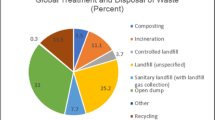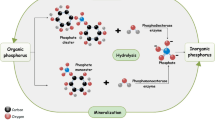Abstract
The objective of this work was to determine (1) the effect of rotational speed (N) and lifters on the oxygen transfer coefficient (k L) of a mineral solution and (2) the effect of solids concentration of a slurry soil-mineral solution on k L, at a fixed value N (0.25 s−1); in both cases the treatment was carried out in an aerated rotating drum reactor (RDR) operated at atmospheric pressure. First, the k L for the mineral solution was in the range 6.38 × 10−4–7.69 × 10−4 m s−1, which was of the same order of magnitude as those calculated for closed rotating drums supplied with air flow. In general, k L of RDR implemented with lifters was superior or equal to that of RDR without lifters. For RDR implemented with lifters, k L increased with N in the range 6.65 × 10−4–10.51 × 10−4 m s−1, whereas k L of RDR without lifters first increased with N up to N = 0.102 s−1, and decreased beyond this point. Second, regarding soil slurry experiments, an abrupt fall of k L (ca. 50%) at low values of the solid concentration (C v) and an asymptotic pattern at high C v were observed at N = 0.25 s−1. These results suggest that mass transfer phenomena were commanded by the slurry properties and a semi-empirical equation of the form Sh = f(Re, Sc) seems to corroborate this finding.





Similar content being viewed by others
Abbreviations
- A :
-
gas–liquid interfacial area in the rotating drum (m2)
- A segment :
-
segment of area in the flat face of the rotating drum (m2)
- a :
-
gas–liquid interfacial area per unit liquid (or slurry) volume (m−1)
- b :
-
parameter of Eq. 1
- \( C^{{\text{*}}}_{{{{\rm O}}_{2} }} \) :
-
oxygen saturated solubility (mol O2 m−3)
- \( C_{{\rm O}_2} \) :
-
oxygen concentration in the bulk liquid (mineral solution or slurry) (mol O2 m−3)
- C v :
-
volumetric fraction of solids, dimensionless
- d :
-
parameter of Eq. 1
- d p :
-
diameter of the solid particle
- D h :
-
hydraulic diameter (D h = 4 × r h) (m)
- D AB :
-
oxygen (A) diffusivity in the mineral solution or slurry (B) (m2 s−1)
- Fr :
-
dimensionless number of Froude, \( Fr = \frac{{\upsilon ^{{\text{2}}}_{{{\rm T}}} }} {{g \times D_{{{\rm h}}} }} \)
- g :
-
gravitational acceleration (m s−2)
- H :
-
height of slurry in the RDR, m
- ID:
-
internal diameter of the rotating drum (m)
- IDah :
-
internal diameter of the aeration holes (m)
- k L :
-
coefficient of mass transfer (m s−1)
- k *L :
-
coefficient of mass transfer at large C v (m s−1)
- k L a :
-
volumetric coefficient of mass transfer (s−1)
- k L0 :
-
coefficient of mass transfer in the mineral solution (0% v/v of solids) treated in a rotating drum at 0.25 s−1
- l :
-
cord length of mineral solution (or slurry) in the flat face of the RDR (m)
- L :
-
length of the rotating drum (m)
- m :
-
parameter of Eq. 1
- n :
-
parameter of Eq. 1
- N :
-
rotational speed (s−1)
- N c :
-
critical velocity (s−1)
- OTR:
-
oxygen transfer rate (mol s−1)
- RDR:
-
rotating drum reactor
- Re :
-
dimensionless number of Reynolds, \( Re = \frac{ {\upsilon _{\rm T}} \times \rho \times D_{\rm h} } {\mu } \)
- r :
-
internal radius of the rotating drum (m)
- r h :
-
hydraulic radius (m)
- S :
-
exponent in the Eq. 12. It is interpreted as a sensitivity coefficient, dimensionless
- Sc :
-
dimensionless number of Schmidt, \( Sc = \frac{\mu } {\rho \times D_{\rm AB}} \)
- Sh :
-
dimensionless number of Sherwood, \( Sh = \frac{{k_{{{\rm L}}} \times D_{{{\rm h}}} }} {{D_{{{{\rm AB}}}} }} \)
- V :
-
mineral solution (or slurry) volume (m3)
- μ :
-
viscosity of the mineral solution (Pa s)
- μ B :
-
viscosity of the slurry (Pa s)
- ρ :
-
density of the mineral solution (kg m−3)
- ρ B :
-
density of the slurry (kg m−3)
- υ T :
-
tangential velocity (m s−1)
- A:
-
oxygen
- ah:
-
aeration holes
- B:
-
slurry
- h:
-
hydraulic
References
Kwapinska M, Saage G, Tsotsas E (2006) Mixing of particles in rotary drums: a comparison of discrete element simulations with experimental results and penetration models for thermal processes. Powder Technol 161(1):69–78
Santomaso A, Olivi M, Canu P (2004) Mechanisms of mixing of granular materials in drum mixers under rolling regime. Chem Eng Sci 59(16):3269–3280
Jauhari R, Gray MR, Masliyah JH (1998) Gas-solid mass transfer in a rotating drum. Can J Chem Eng 76:224–232
Shibasaki N, Hirose K, Yonemoto T, Tadaki T (1992) Suspension culture of Nicotiana tabacum Cells in a rotary-drum bioreactor. J Chem Technol Biot 53:359–363
Woo SH, Park JM (1999) Evaluation of drum bioreactor performance used for decontamination of soil polluted with polycyclic aromatic hydrocarbons. J Chem Technol Biotechnol 74:937–944
Brinkmann D, Röhrs J, Schügerl C (1998) Bioremediation of diesel fuel contaminated soil in a rotating bioreactor. Part I: influence of oxygen saturation. Chem Eng Technol Commun 21(2):168–172
Wang SJ, Zhong JJ, Chen YL, Yu JT (1995) Characterization and modelling of oxygen transfer in a 20l modified cell-lift bioreactor with a double-screen cage. J Ferment Bioeng 80(1):71–77
Maier B, Dietrich C, Büchs J (2001) Correct application of the sulphite oxidation methodology of measuring the volumetric mass transfer coefficient kLa under non-pressurized and pressurized conditions. Trans IChemE 79(Pt C):1–7
Yang JD, Wang NS (1992) Oxygen mass transfer enhancement via fermentor headspace pressurization. Biotechnol Prog 8(3):244–251
Kubsad V, Chaudhari S, Cupta SK (2004) Model of oxygen in rotating biological contactor. Water Res 38:4297–4304
Hardin MT, Howes T, Mitchell DA (2000) Mass transfer correlations for rotating drum bioreactors. J Biotechnol 297:89–101
Kawase Y, Halard B, Moo-Young M (1992) Liquid-phase mass transfer coefficients in bioreactors. Biotech Bioeng 39:1133–1140
Reuss M (1993) Oxygen transfer and mixing scale-up implications. In: Rehm HJ, Reed G (eds) Biotechnology, vol 3 (Bioprocessing). VCH, Weinheim, pp 190–217
Welty JR, Wicks CE, Wilson RE, Gregory R (2001) Fundamentals of momentum, heat and mass transfer, 4th edn. Wiley, USA
Manilla-Pérez E, Poggi-Varaldo HM, Chávez-Gómez B, Esparza-García F, Barrera-Cortés J (2004) Evaluation of a rotatory drum used for bioremediation of a hydrocarbon contaminated soil (in spanish). Interciencia 29(9):515–520
Clescer LS, Greenberg AE, Trussell RR (eds) (1989) Standard methods for examination of water and wastewater, 17th edn, APHA, AWWA and WPCF, Washington DC, USA
Bailey J, Ollis DF (1986) Biochemical engineering fundamentals, 2nd edn. McGraw Hill, USA, pp 16–24
Perry RH, Chilton CH (1973) Chemical engineers’ handbook. MacGraw-Hill International Company, USA
Gray MR, Mehta B, Masliyah JH (1993) Liquid-side mass transfer coefficients for liquids and slurries in a rotating drum. Chem Eng Sci 48 (19):3442–3446
Hermann R, Walther N, Maier U, Büchs J (2001) Optical method for the determination of the oxygen-transfer capacity of small bioreactors based on sulfiteoxidation. Biotech Bioeng 74:355–363
Brady NC (1974) The nature properties of soils. MacMillan, New York
McCabe W, Smith J, Harriot P (2001) Unit operations of chemical engineering, 6th edn. McGraw Hill, USA
Van der Gulik GJS, Wijers JG, Keurentjes JTF (2001) Hydrodynamics and scale-up of horizontal stirred reactors. Ind Eng Chem Res 40:4731–4740
Mukhopadhyay SN, Ghose TK (1978) Oxygen transfer in laboratory horizontal rotary fermentor under varying speed. J Ferment Technol 56(5):558–560
Subrata KM, Kamal Ch, Dhiren SD, Gautam K (2006) Studies on flow characteristics of coal–oil–water slurry system. Int J Miner Process 79(4):217–224
Alper E, Wichtendahl B, Deckwer WD (1980) Gas absorption mechanism in catalytic slurry reactors. Chem Eng Sci 35:217–220
Miyachi M, Iguchi A, Uchida S, Koide K (1981) Effect of solid particles in liquid-phase on liquid-side mass transfer coefficient. Can J Chem Eng 59:640–641
Joosten GEH, Schilder JGM, Janssen JJ (1977) The influence of suspended solids material on the gas-liquid mass transfer in stirred gas-liquid contators. Chem Eng Sci 32:563–566
Baldwin S, Cheng RC, Demopoulos GP (2000) A contribution to the measurement of oxygen mass transfer in a laboratory pressure reactor. J Chem Technol Biotechnol 75:665–672
Tanaka H, Nishijima F, Suwa M, Iwamoto T (1983) Rotating drum fermentor for plant cell suspension cultures. Biotech Bioeng 25:2359–2370
Acknowledgment
Authors wish to thank to CONACYT and SEMARNAT for the financial support of this work through the project SEMARNAT-2002-C01-0154.
Author information
Authors and Affiliations
Corresponding author
Rights and permissions
About this article
Cite this article
Barrera-Cortés, J., Manilla-Pérez, E. & Poggi-Varaldo, H.M. Oxygen transfer to slurries treated in a rotating drum operated at atmospheric pressure. Bioprocess Biosyst Eng 29, 391–398 (2006). https://doi.org/10.1007/s00449-006-0088-6
Received:
Accepted:
Published:
Issue Date:
DOI: https://doi.org/10.1007/s00449-006-0088-6




